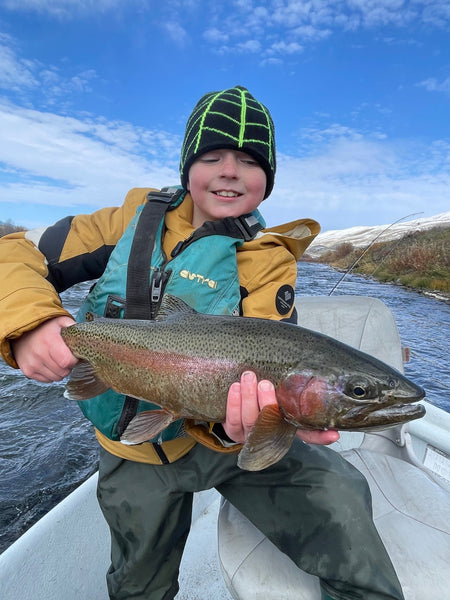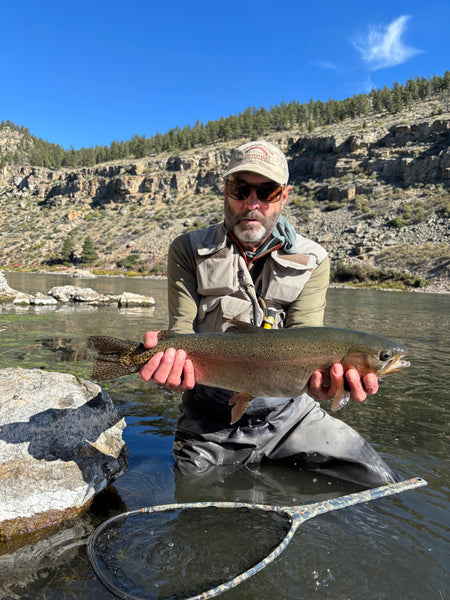Trout Fishing With Wet Flies
January 29, 2019
Part 1 of 3 Back to: Part 2 Part 3
Trout Fishing With Wet Flies
When I first moved to West Yellowstone, I was very focused on improving my fishing skills for nymphs and dry flies. The best anglers I knew were masterful with nymphs and I focused much of my attention in learning to be more effective fishing this way. When the midsummer hatches started, I then took every opportunity to fish on the surface with dry flies. As the years went on, I fished little with wet flies except a bit on the Firehole River in the springtime and again on the Madison River in the Park for lake run fish in the fall. Other times of the year I ignored wet flies completely, thinking that our educated fish would only fall for a dead drifted fly. Wets to me were an outdated technique that was great for fishing to stockers, but of little importance to a modern effective fisherman targeting wild, selective trout.
This opinion began to change one day when I was guiding a gentleman in Yellowstone Park. We had a bit of action in the Northeast Corner on dries, but the fish were tough to fool and even tougher to hook while fishing on top. My angler switched to wets, as they were his confidence flies from fishing back east. Shortly thereafter, he fooled some fish and my curiosity was raised. After this day I have played around with wet flies and soft hackles throughout Montana and the rivers in Yellowstone and have found them to be a quite enjoyable and productive to fish.
In this series of posts we will look at why to fish wets and when they are effective. We will then look at how properly rig a wet fly rig on both single handed rods and light trout Spey set ups. After this, we will move into casting and proper presentation followed by how to hook up more fish and the best ways to effectively cover water.
Most anglers, like I did, overlook fishing Wet Flies. There are many reasons why more anglers should try fishing wet flies. Wets are a great way to cover water. They are far more enjoyable to cast than a weighted nymph or streamer rig and are a great alternative to watching a strike indicator float down the river. Because the rigging is so simple, it is easy to switch from wets to dry flies without having to totally rerig. Wets are also effective in a wide range of water types and there isn’t a trout fishery in the area that they aren’t effective on, provided they are fished at the right times. Wet flies can take some of the guesswork out of fly selection, as you don’t have to specifically match each insect the trout may see. Lastly fishing with wets is enjoyable and relaxing, requiring less focus than other fishing techniques as you feel every bite and there is no need for a lightning fast hookset.
We will be discussing when and how to rig and fish wet flies and soft hackles in the streams in the area. This topic will focus strictly on the fishing the Wet Fly swing. While there are many different ways to fish wet flies and soft hackles, for the sake of brevity, we will be only discussing the swung fly. I will also use the term wet fly to describe all wets, which soft hackles are included in. There is no practical difference in how I fish different sorts of wet fly patterns of which soft hackles are one type.
Wet fly and soft hackle fishing is at its best when the fish are active. Warmer water and aquatic insect activity of late spring signal the start of our wet fly fishing for the year. Wets are very effective during sparse hatches that have fish rising occasionally. While swinging wets can be effective on sunny days, a bit of cloud or the dull light of morning and evening is ideal for the technique. Wets are a great choice late in the evening when it is tough to see a dry fly and the fish are actively feeding.
Most literature on the subject suggests that periods of Caddis insect activity are a great time to fish a wet fly as the movement of the fly does a good job of imitating emerging caddis. I have often found the method equally as effective during Mayfly emergence as well.
Next time you are on the water and conditions are right, try a Wet Fly or Soft hackle. Part two will cover how to rig up to fish Wets with both Trout Spey gear and traditional single hand rods.
Be sure to check back next week for article 2 of this 3 part series.

Above - A selection of some of Mike's favorite Wet Flies

About Mike Loebl - Professional Fly Fishing Guide at Madison River Outfitters, West Yellowstone, MT

Mike began fly fishing at the age of 7 in his home state of Michigan, where he would later start his career in the industry at a fly shop in Northville. Fast forward to the present and Mike has been with MRO for the better part of the past two decades. Not only is Mike a certified FFF casting instructor, but he is also well versed in both spey casting and Czech nymphing. As a guide, Mike loves to teach people new techniques and help improve upon what they already know. When not fishing, Mike can be found spending time with his wife Alice Owsley (also a fly fishing guide in the area) and their dog Norman.
7 Responses
Tom Anglim
I am 76yrs old and have found wet fly fishing to be a easy way for me to wade. I park myself in the middle of the stream and fish both sides on my way down. Enjoyed your article on wets looking foreword to next one .Tight lines
Henry J Cicutto
Mike,
Read the article and enjoyed very much, as well as learning a tremendous amount about swinging a soft hackle. I am curious as to your fishing with any of the classic winged wet flies and the ratio of success.
TERRY ZOLOTOFF
Even after flyfishing for more than 40 years, I learn something new every trip with Mike! Great guide who makes me look like I know what I’m doing!
John Schilling
Hi John – sorry we forgot to post some sample pictures of Wet Flies. We’ve added those have now been added to this article above.
Nick Grogan
Not only a great guide, but truly a nice person, fun to be with.
tom croyle
Mike is the best !! But don’t tell em all our secrets !
John Hancock
Mike-nice article and I look forward to the rest in the series. Can you tell me some examples of what you consider wet flies? Thanks.
Leave a comment
Comments will be approved before showing up.
Also in Madison River Fishing Report - Upper Madison River Fishing Report - Greater Yellowstone Area Fishing Reports

Madison River Outfitters Fishing Report for 10/21/2025
This is the Last Report of the Year! Have a Great Winter, and We'll See You All This Spring!!




Mike Loebl
Author